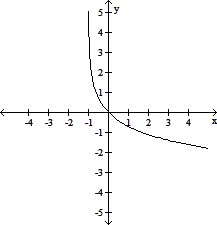Graph the function and analyze it for domain, range, continuity, increasing or decreasing behavior, symmetry, boundedness, extrema, asymptotes, and end behavior.f(x) = - ln (x + 1)
What will be an ideal response?

The domain is (-1, ?), and the range is all real numbers. The function is continuous and decreasing on its domain. There is no symmetry. It is not bounded above or below. There are no local extrema. The vertical asymptote is x = -1. The end behavior is described by  f(x) = - ?.
f(x) = - ?.
You might also like to view...
Solve the system by the elimination method or a combination of the elimination and substitution methods.x2 + 3xy + y2 = 4 x2 - 3xy - y2 = 4
A. {(2, 0), (-2, 0), (2, -6), (-2, 6)} B. {(2, -6), (-2, 6)} C. {(0, 2), (0, -2), (2, -6), (-2, 6)} D. {(2, 0), (-2, 0)}
Provide an appropriate response.Simplify and express your answer in terms of positive exponents; rationalize the denominator to avoid fractional exponents in the denominator: 
What will be an ideal response?
Solve the equation.4(3x - 1) = 16
A. 
B. 
C. 1
D. 
Solve the problem.A promotional deal for long distance phone service charges a $15 basic fee plus $0.05 per minute for all calls. Use a linear model to find how many minutes of phone calls Joe made if his phone bill was $65. Round to the nearest minute, if necessary.
A. 1000 B. 3 C. 1600 D. 10